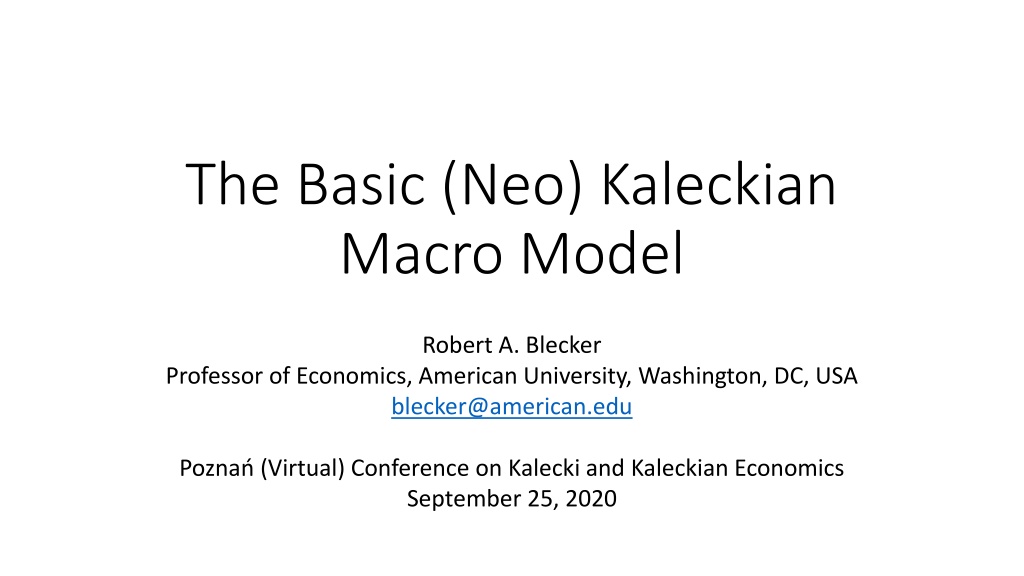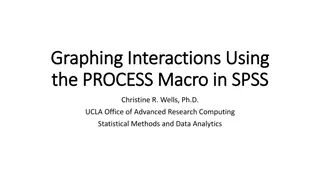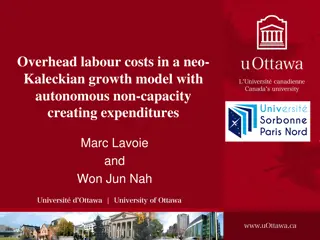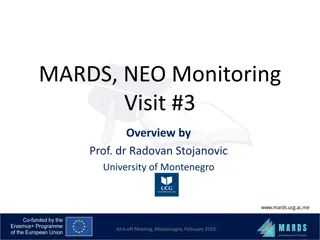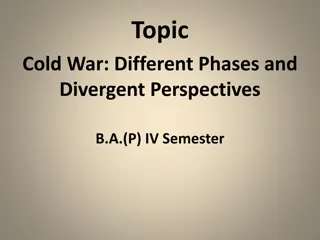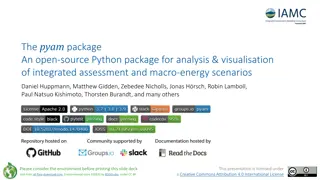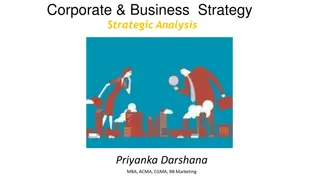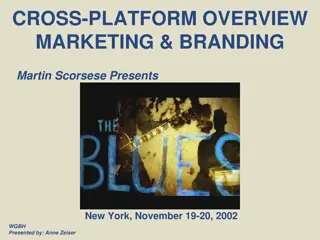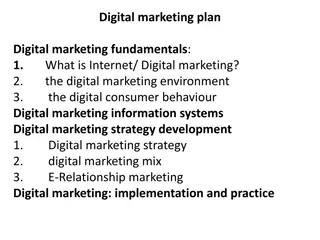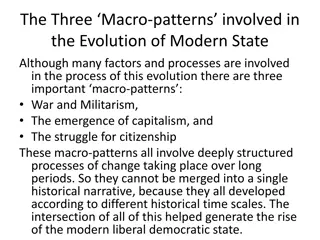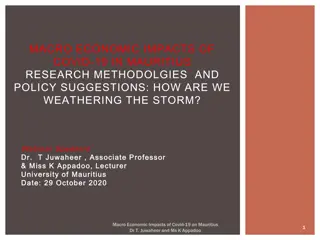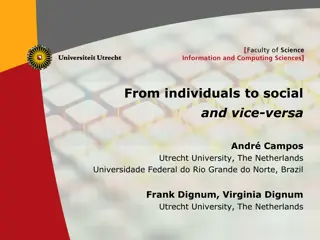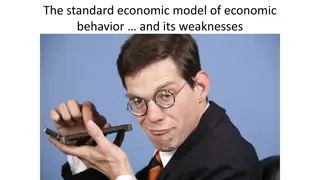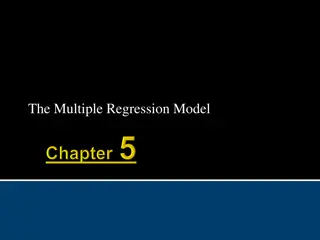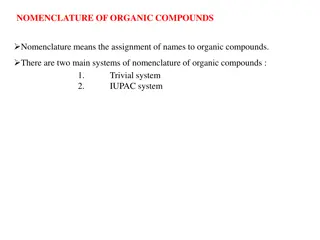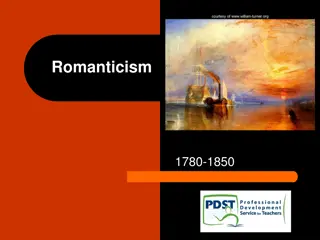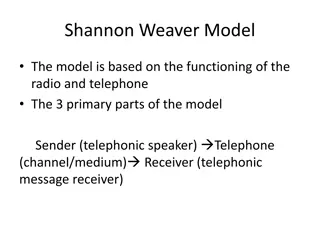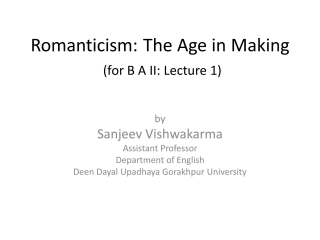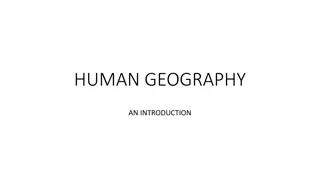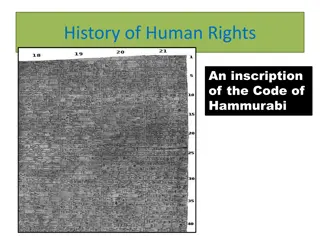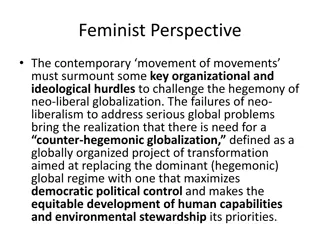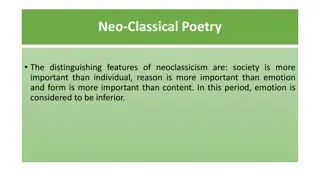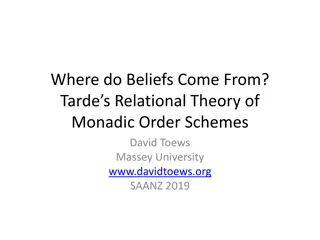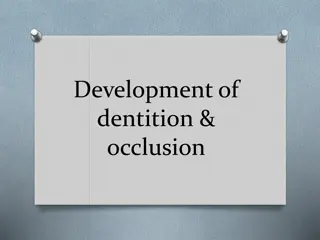Neo-Kaleckian Macro Model Overview
This presentation explores the Neo-Kaleckian macroeconomic models, examining their development, key elements, and unique features within the broader context of economic theories. It delves into the first-generation models by Harris and Asimakopulos, focusing on markup pricing, labor costs, profit share, and labor productivity, shedding light on how these models analyze macroeconomic outcomes.
Download Presentation

Please find below an Image/Link to download the presentation.
The content on the website is provided AS IS for your information and personal use only. It may not be sold, licensed, or shared on other websites without obtaining consent from the author. Download presentation by click this link. If you encounter any issues during the download, it is possible that the publisher has removed the file from their server.
E N D
Presentation Transcript
The Basic (Neo) Kaleckian Macro Model Robert A. Blecker Professor of Economics, American University, Washington, DC, USA blecker@american.edu Pozna (Virtual) Conference on Kalecki and Kaleckian Economics September 25, 2020
Introduction and outline This will not be an exegesis of Kalecki s own macro models What this presentation will cover: Neo-Kaleckian models First, second, and third generation Developed between the 1970s and 1990s Simplified versions for presentational purposes These models do reflect Kalecki s original ideas, to varying degrees Major extensions and applications of these models Huge literatures, very briefly summarized Including empirics, critiques, and debates Mainstream echoes Conclusions and suggestions 2
Whats unique unique in Kaleckian macro modeling Other theories accept some of the pieces For example, other models have oligopolistic firms or mark-up pricing Many economists acknowledge that the rich have a lower MPC There is much interest in increased inequality and falling labor shares today What s unique is the way the Kaleckian tradition puts all this together: Oligopolistic markup pricing profit/wage shares consumption and investment spending, net exports macroeconomic outcomes (utilization, employment, growth, productivity) feedbacks to markups and distribution Nevertheless, it s not a complete macro framework It needs to be augmented with analyses of money, finance, inflation, technology, labor bargaining, public sector, other forms of inequality, etc. 3
First generation models: First generation models: Harris (1974) and Asimakopulos (1975)* Markup pricing on unit labor costs: P = (1 + )Wa0 National income identity: PY = + WL Two kinds of labor: L = L0 + L1 Production worker hours are proportional to output: L0 = a0Y Overhead (professional/managerial) labor L1 is exogenously fixed Same wage rate for simplicity Solve for profit share and labor productivity Q: ( ) 1 PY + *Simplified version of the common elements in both Y L Y L a Y = = = = Q 1 0 + a Y L 0 1 Profit share is positively related to the markup rate Both are positively related to output Y (procyclical) if L1 > 0 4
Short-run equilibrium in the first generation model Workers do not save (for simplicity): S = sr Investment is exogenous: Saving = investment equilibrium Equilibrium solutions: sr is the propensity to save out of profits = I I = rs PI The profit share is positively related to Output is inversely related to the markup Stagnation results when greater monopoly power causes markups and the profit share to increase and output is depressed A cyclical rise in investment will increase both Y* and *, creating a false impression of profit-led demand + I = * + (1 ) ( ) I s L a 1 0 r + + (1 ) ( ) I s L a = * 1 0 r Y s r 5
Second generation models: Second generation models: Del Monte (1976); Rowthorn, Dutt, Taylor, and others (early 1980s)* The main innovations were to endogenize investment and to model capacity utilization and growth explicitly One simplification (not essential): No overhead labor (L1 = 0) The profit share depends only on the markup *Again, a simplified version of their common elements, also incorporating Steindl (1952, 1979) + = 1 The real wage is 1 + 1 a 1 W P = = = w 1 a 0 0 6
Realized profit and saving rates Note that both of these depend on capacity utilization! The realized profit rate is + Y K u = = r 1 a 1 where a1 = K/YP is the ratio of capital to potential output, YP(capacity) and u = Y/YP is the capacity utilization rate with 0 < Y YP and 0 < u 1 under normal conditions With no saving out of wages, the saving rate (saving-capital ratio) is S K = = = u a s r s 1 r r 7
The Kalecki-Steindl investment function (Dutt, 1987) and equilibrium utilization and growth g = I/K = g0 + g1r + g2u, g0, g1, g2 > 0 Incorporates realized profits Which provide internal finance of investment (relax financial constraints) And a separate accelerator effect of capacity utilization Given the equilibrium condition = g, solutions are: g u s g a g ( ) s g a a = = = * * * 0 0 )( 1 r g g ( )( ) ( ) s g 1 1 2 1 1 2 r r where assuming the stability condition holds 1 1 2 ( )( ) 0 g a g rs 8
Key implications: cooperative stagnationism or an all-wage-led demand regime An increase in the profit share (markup rate) reduces utilization, growth, and the realized profit rate: Assuming that the stability condition holds and g0, g1, g2 > 0 = * * ( ) ) g s g g a a g g a u r = 0 0 2 1 0 0 1 1 g r 2 2 [( )( ) ] s g a g [( )( ] s 1 1 2 r 1 1 2 r Wage-led demand or stagnationism Paradox of costs or cooperative stagnationism Note: Marglin and Bhaduri (1990) saw this regime as permitting a class com- promise over distribution and growth, but Kalecki (1943) was skeptical that capitalists would in fact cooperate. * * s g g a g g = = 0 0 2 a 1 r 2 [( )( ) ] s g 1 1 2 r Wage-led growth 9
Third generation models: Third generation models: Profit-led vs. wage- led demand regimes (late 1980s-early 1990s) Sometimes called post-Kaleckian Identified three routes to showing the possibility of profit-led demand: 1. Positive saving out of wages (Harris; Taylor; Mott and Slattery)* 2. More general investment function (Bhaduri-Marglin; Kurz) 3. Open economy/international competition (Blecker) * Harris (1974) included positive saving out of wages in a model with exogenous investment. Asimakopulos (1975) considered household vs. corporate saving in an appendix. I explored positive saving out of wages in my 1986 doctoral dissertation, but did not include it in the published version in Blecker (1989). 10
1. Positive saving out of wages Perhaps the simplest and most obvious approach, but has received the least attention = S/K = [sr + sw(1 )]u/a1 where 0 sw < sr 1 Setting = g and using the Kalecki-Steindl investment function for g: = + * ( ) < 0 (wage-led) if sr sw > g1 > 0 (profit-led) if sr sw < g1 g s g s a g a a u 0 1 s 1 r w 2 [( )( ) ( ) ] s s g Effects of different tax rates out of wage and profit income are analogous: the bigger the gap (tr tw), the more likely demand is wage-led 1 1 1 2 r w w is ambiguous in sign (even if stability holds) the same is true for r*/ , g*/ = */ 11
2. Bhaduri-Marglin investment function g = f [r e( , u)] = h( , u); h , hu > 0 Melds Robinson s emphasis on expected profitability with Kalecki s assumption of variable capacity utilization Uses the profit share instead of the profit rate to avoid double-counting of utilization, which imposes a strong accelerator effect Allows for a strong profitability effect, but neglects the Kalecki-Steindl emphasis on realized profits generating internal funds (Minsky s cash flow ) Even with no saving out of wages, demand (utilization) can be either wage-led or profit-led: * * 1 ( ) ( ) r u s a h is ambiguous in sign even if the stability condition holds h s u a u = r 1 In a closed economy with no government or saving out of wages, the profitability effect must be very strong [elasticity ( /g*)h > 1] for demand to be profit-led! 12
3. Open economy/international competition Assume a flexible markup that adjusts to the real exchange rate to maintain competitiveness of domestic firms (like partial exchange-rate pass-through) > 1 is a target markup factor reflecting monopoly power of firms > 0 is the degree to which a real currency appreciation squeezes the markup EP P Analogous to effects of labor cost increases in particular firms or sectors (Kalecki, 1971a) f + = 1 The profit share becomes endogenous = ( , ), z 0; 0 z where z = EPf /Wa0 reflects home-country competitiveness in unit labor costs Not only can demand be either wage-led or profit-led, but the outcome depends on the source of a distributional shift (monopoly power vs. cost competitiveness z) 13
The general open economy model also includes: A linearized Bhaduri-Marglin investment function g = I/K = h0 + h1( f ) + h2u/a1, h1, h2 > 0 A simplified trade balance function b1 > 0 assumes that Marshall-Lerner holds b2 > 0 implicitly assumes that exports rise with the capital stock b = B/K = b(EPf /P, u/a1), b1, b2 > 0 Positive saving out of wages = S/K = [sr + sw(1 )]u/a1 Equilibrium condition = g + b 14
Wage-led () versus profit-led (+) demand in the open economy Profit margin effect on net exports ( ) Profitability effect on consumption ( ) Profitability effect on investment (+) Changes in monopoly power are more likely to have wage-led effects u a ) [ + + * ( )( (1 )(1 )] h s s z b * u 1 1 1 r w = Note opposite signs!* Increased competitiveness effect on net exports (+) Profitability effect on consumption ( ) Profitability effect on investment (+) Changes in labor cost competitiveness are more likely to have profit-led effects ) [1 (1 + + + * * ( )( )(1 )] h s s u a b u z = 1 1 1 z r w z *A higher weakens either effect on net exports. 15
Main implications of basic neo-Kaleckian models Demand and growth are more likely to be wage-ledif: The gap in saving propensities (sr sw) is large relative to the profit effect on investment (g1 or h ) There is a strong accelerator effect on investment (g2 or hu) Distributional shifts are caused mainly by changes in the monopoly power of firms Rather than shocks to unit labor costs The economy is relatively closed or net exports are not very sensitive to relative prices Especially for shocks to unit labor costs (or if markups are relatively sensitive to ULC) If changes in unit labor costs are similar across countries rather than only in one country The tax system is more progressive (there is a relatively large gap, tr tw) Demand and growth are more likely to be profit-led in the opposite cases The exact conditions will vary for demand (u) and growth (g) and for different shocks to distribution (in the open economy case) 16
Extensions, applications, and debates (I) North-South trade and uneven development Structuralist models of developing countries Two-country models more broadly Connections to balance-of-payments-constrained growth; impact of currency depreciation Other dimensions of income distribution and inequality Retained profits of firms vs. interest or dividend income of rentiers (or banks) Wage inequality by type of labor (e.g., managers vs. production workers) Gender wage gaps and gender differences in paid and unpaid employment Could also be extended to modeling racial/ethnic differences, immigrant labor, etc. Endogenizing income distribution and technology Incorporating labor markets, unemployment, wage bargaining, and endogenous productivity growth Effects of distributional shifts on employment can differ from effects on output Note: References to these vast literatures are too numerous to include in these slides. 17
Extensions, applications, and debates (II) Debate over whether capacity utilization is endogenous in the long run Is there convergence to a normal rate of utilization? If so, is the normal rate unique or can it vary? More broadly, are neo-Kaleckian models short-run in nature, or can they be applied to long-run steady states? Introducing Harrodian instability in a Kalecki-Robinson model Alternative ways of taming the instability (e.g., in the autonomous component of investment) can lead to different resolutions of the normal utilization controversy Kaleckian supermultiplier models Output grows at an exogenous rate and utilization converges to the normal rate in the long run (by assumption) Growth is driven by an autonomous component of demand (non-capacity creating) But distribution can still affect the long-run level of output (growth path) 18
Extensions, applications, and debates (III) Empirical literature estimating model parameters and testing whether countries have wage-led or profit-led demand (or growth) huge! Results are mixed and differ by methodology, short-run vs. long-run, type of country (large vs. small, more open or closed), types of distributional shocks, etc. Conflicting claims inflation An alternative to monetarist stories about inflation Also endogenizes income distribution (profit or wage share and markup rate) Neo-Goodwin cycle models are an offshoot of this They assume profit-led demand and a profit-squeeze in distribution Can be criticized for ignoring the cyclicality of labor productivity and the profit or wage share, which may bias empirical estimates 19
Extensions, applications, and debates (IV) Incorporating monetary policy, interest rates, and financialization Often using stock-flow consistent methods to model financial relationships Dynamics of corporate and/or household debt and macro instability Sometimes including Veblen-Duesenberry emulation effects or expenditure cascades in household expenditures Sometimes linked to Minskyan views on financial fragility and crises Applications to current debates about inequality and stagnation Reviving Steindl s views on long-term stagnation Alternatives to Piketty s interpretation of r > g in explaining wealth inequality The role of fiscal policy Including the benefits of public investment, critiques of austerity policies, and the distributional incidence of tax systems 20
Kaleckian echoes in mainstream macro (unrecognized influences or uncited rediscoveries) Neoclassical models of financial constraints on investment importance of internal finance (cash flow) out of corporate profits New Keynesian macro models incorporating imperfect competition (monopolistic or oligopolistic) Heterogeneous agent models assuming different saving behavior of different classes of agents Labor rents literature recognizes workers bargaining for a portion of oligopolistic profits ( Class struggle and the distribution of national income ) Heterogeneous firms in trade and macro models New attention to increasing concentration, rising profit markups, falling labor shares, and their relationship to inequality and stagnation tendencies 21
Concluding thoughts for discussion Recall Kalecki sdictum: the long-run trend is but a slowly changing component of a chain of short-period situations; it has no independent entity (Kalecki, 1971b, p. 165) Neo-Kaleckian models can be used to represent the short run in models with another characterization of the long run (classical-Marxian, supermultiplier, BOP-constrained, etc.) Alternatively, neo-Kaleckian models can be seen as depicting an evolving sequence of short- run periods, without presuming a tendency toward a predetermined long-period outcome We should try to reintegrate Kaleckian microfoundations with the macro models Kalecki and Steindl grounded their macro models in micro-level analyses of absolute concentration, oligopolistic competition, and the degree of monopoly Updating these foundations needs more attention and more linkages to the macro models This could help to resolve the disputes over how normal utilization evolves and to address current policy issues related to rising monopoly power of large firms 22
